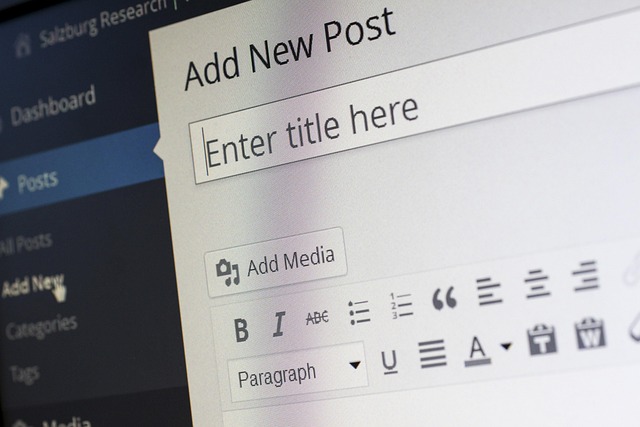An internal link audit for WordPress optimizes site structure and SEO by identifying key pages, analyzing anchor text relevance, fixing broken links, and ensuring contextual linking. This process enhances user experience, improves search rankings, and requires utilizing analytics tools to track key metrics like CTR, bounce rates, and time spent on pages.
Marketers aiming to enhance their website’s performance through strategic internal linking can benefit from this comprehensive guide. Focus on optimizing your WordPress site structure by understanding the fundamentals of internal linking, identifying key pages for targeted connections, and conducting a thorough internal link audit. Analyze anchor text and ensure contextual relevance while enhancing user experience through streamlined site structure. Finally, measure success with analytics tools, leveraging insights to refine your SEO strategy via effective internal link audits for WordPress.
- Understand WordPress Internal Linking Basics
- Identify Key Pages for Strategic Linking
- Conduct Comprehensive Internal Link Audit
- Analyze Anchor Text and Contextual Relevance
- Optimize Site Structure for User Experience
- Measure Success with Analytics Tools
Understand WordPress Internal Linking Basics

Understanding WordPress Internal Linking Basics is a crucial step for marketers aiming to optimize their site structure through smart internal linking. WordPress, as one of the most popular content management systems, offers a variety of tools and plugins designed to facilitate effective internal link creation and management. An internal link audit for WordPress involves meticulously analyzing your website’s links to ensure they are relevant, contextual, and contribute to a seamless user experience.
During this process, you’ll want to consider an internal link audit strategy that includes both technical and content-focused aspects. For instance, performing internal link audit optimization by removing broken links, updating anchor text for better relevance, and ensuring proper link hierarchy can significantly enhance your website’s SEO performance. Following internal link audit tips such as prioritizing high-quality content with relevant backlinks and using keyword-rich anchor text can further strengthen your site’s search engine visibility and user engagement.
Identify Key Pages for Strategic Linking

When conducting an internal link audit for WordPress sites, identifying key pages is a strategic first step. Marketers should focus on high-value pages that serve as hubs within their site’s architecture. These could be category or product pages in e-commerce sites, essential blog posts or articles in content-rich websites, or even the homepage and about us page for smaller businesses. Understanding the hierarchy and importance of these pages is crucial for effective internal linking, as it ensures relevant traffic flows to where it matters most.
An internal link audit tutorial would highlight how to analyze user behavior, bounce rates, and time spent on each page to pinpoint these key pieces. This process involves going beyond simple page views and delving into the quality of engagement. Once identified, these pages become strategic anchors for contextual links, enhancing both SEO and user experience by providing a seamless navigation journey throughout the website.
Conduct Comprehensive Internal Link Audit

Before implementing any internal linking strategy, conducting a comprehensive internal link audit for WordPress is a crucial step. This involves meticulously analyzing your site’s current internal links to identify issues like broken or outdated links, missing anchor text, and low-quality backlinks. An internal link audit optimization allows you to assess the overall health of your website’s navigation structure and understand how search engines perceive your content.
By following an internal link audit tutorial, marketers can develop a strategic plan that enhances user experience and boosts SEO performance. This process includes evaluating link relevance, ensuring proper anchor text usage, and fixing any technical issues hindering efficient crawling. A well-executed internal link audit strategy not only improves site structure but also helps in passing on authority and value between relevant pages, ultimately contributing to better search engine rankings.
Analyze Anchor Text and Contextual Relevance

When conducting an internal link audit for WordPress sites, meticulously analyzing anchor text is paramount. Marketers should scrutinize the keywords used in anchor text to ensure they are relevant to the linked content. This strategy not only improves search engine optimization (SEO) but also enhances user experience by providing contextually relevant navigation. Avoid using generic anchor text like “click here” or “more info,” as these offer little to no SEO value and fail to convey the topic of the linked page.
The internal link audit tips extend beyond anchor text analysis. Contextual relevance is key; links should point to content that naturally flows from the source page. This means creating a structured, hierarchical network where each internal link serves a purpose by guiding users and search engines to relevant information. An internal link audit tutorial can guide marketers through identifying weak or missing links, broken links, and duplicate content, all of which hinder site structure and SEO performance.
Optimize Site Structure for User Experience

Optimizing site structure for user experience is a critical component of any effective digital marketing strategy, especially when aiming to enhance search engine optimization (SEO) through internal linking. A well-structured website not only improves navigation but also ensures that each page has the opportunity to contribute to the overall authority and relevance of the domain. For WordPress sites, conducting a comprehensive internal link audit is a game-changer. This involves meticulously analyzing the site’s current internal linking pattern, identifying broken or missed links, and strategically placing relevant internal links to create a seamless user journey.
By implementing a robust internal link audit strategy, marketers can uncover valuable insights into page importance and interconnections. An internal link audit tutorial for WordPress users might include steps like scanning for low-quality or duplicate content pages that need linking, ensuring proper anchor text usage for contextual relevance, and prioritizing critical pages to be linked from relevant and high-ranking sources within the site. Such an approach not only improves user experience but also signals search engines about the importance of specific pages, boosting overall SEO performance.
Measure Success with Analytics Tools

To measure the success of your internal linking strategy, utilizing analytics tools is a must for any marketer looking to optimize their site structure through WordPress. Start by conducting a comprehensive internal link audit to identify weak links and opportunities for improvement. This involves analyzing every link on your website to understand its purpose, context, and performance.
Once the audit is complete, you can use SEO-focused analytics tools to track key metrics like click-through rates (CTR), bounce rates, and time spent on pages. These insights will help you refine your internal linking strategy, ensuring that links are contextual, relevant, and effective in guiding users through your site’s information architecture. The goal is to create a seamless user experience while also enhancing SEO performance, which can be accomplished through consistent internal link audit optimization using WordPress-specific tools.
